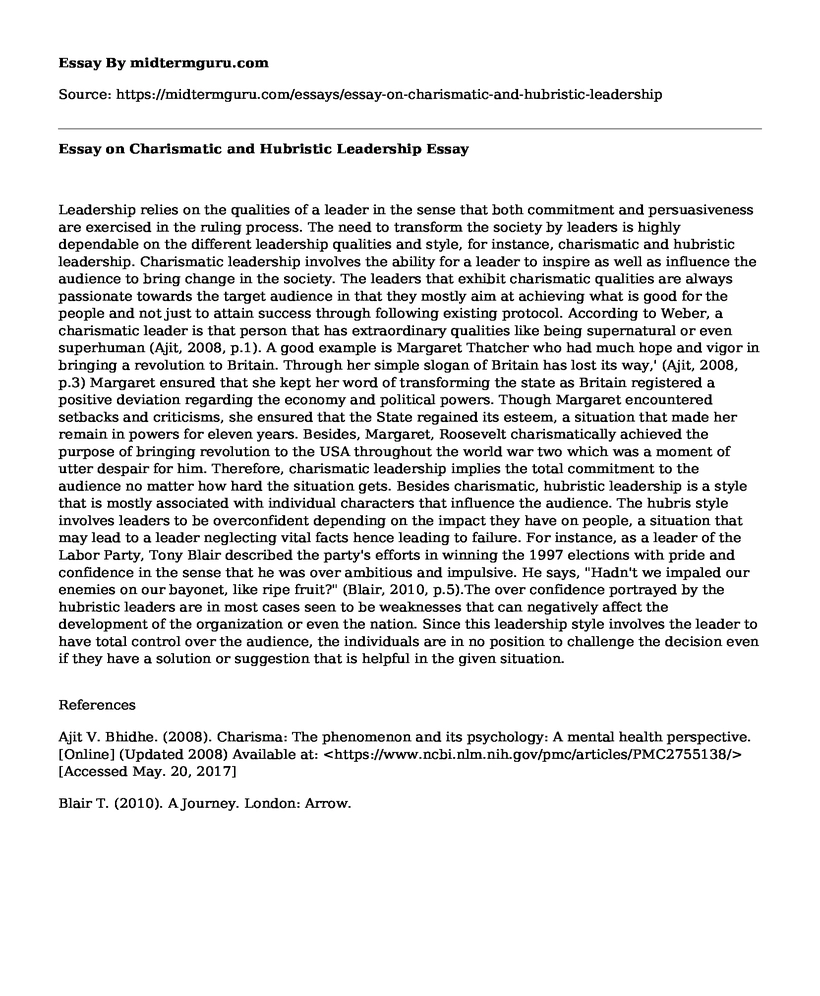Leadership relies on the qualities of a leader in the sense that both commitment and persuasiveness are exercised in the ruling process. The need to transform the society by leaders is highly dependable on the different leadership qualities and style, for instance, charismatic and hubristic leadership. Charismatic leadership involves the ability for a leader to inspire as well as influence the audience to bring change in the society. The leaders that exhibit charismatic qualities are always passionate towards the target audience in that they mostly aim at achieving what is good for the people and not just to attain success through following existing protocol. According to Weber, a charismatic leader is that person that has extraordinary qualities like being supernatural or even superhuman (Ajit, 2008, p.1). A good example is Margaret Thatcher who had much hope and vigor in bringing a revolution to Britain. Through her simple slogan of Britain has lost its way,' (Ajit, 2008, p.3) Margaret ensured that she kept her word of transforming the state as Britain registered a positive deviation regarding the economy and political powers. Though Margaret encountered setbacks and criticisms, she ensured that the State regained its esteem, a situation that made her remain in powers for eleven years. Besides, Margaret, Roosevelt charismatically achieved the purpose of bringing revolution to the USA throughout the world war two which was a moment of utter despair for him. Therefore, charismatic leadership implies the total commitment to the audience no matter how hard the situation gets. Besides charismatic, hubristic leadership is a style that is mostly associated with individual characters that influence the audience. The hubris style involves leaders to be overconfident depending on the impact they have on people, a situation that may lead to a leader neglecting vital facts hence leading to failure. For instance, as a leader of the Labor Party, Tony Blair described the party's efforts in winning the 1997 elections with pride and confidence in the sense that he was over ambitious and impulsive. He says, "Hadn't we impaled our enemies on our bayonet, like ripe fruit?" (Blair, 2010, p.5).The over confidence portrayed by the hubristic leaders are in most cases seen to be weaknesses that can negatively affect the development of the organization or even the nation. Since this leadership style involves the leader to have total control over the audience, the individuals are in no position to challenge the decision even if they have a solution or suggestion that is helpful in the given situation.
References
Ajit V. Bhidhe. (2008). Charisma: The phenomenon and its psychology: A mental health perspective. [Online] (Updated 2008) Available at: <https://www.ncbi.nlm.nih.gov/pmc/articles/PMC2755138/> [Accessed May. 20, 2017]
Blair T. (2010). A Journey. London: Arrow.
Cite this page
Essay on Charismatic and Hubristic Leadership. (2021, Jul 02). Retrieved from https://midtermguru.com/essays/essay-on-charismatic-and-hubristic-leadership
If you are the original author of this essay and no longer wish to have it published on the midtermguru.com website, please click below to request its removal:
- Product Comparison in Terms of Packaging Bottles Designs of Shaving Creams
- Essay on the Auditing of Food Safety Modernization Act (FSMA)
- Essay Sample on Strategies for Change Management
- Paper Example on Sourcing Products in a Global Marketplace
- Defining Leadership and Management - Essay Sample
- Employment Training: Motivation & Quality Service - Research Paper
- Maslow's Motivation Theory: Assumptions & Effects - Essay Sample







